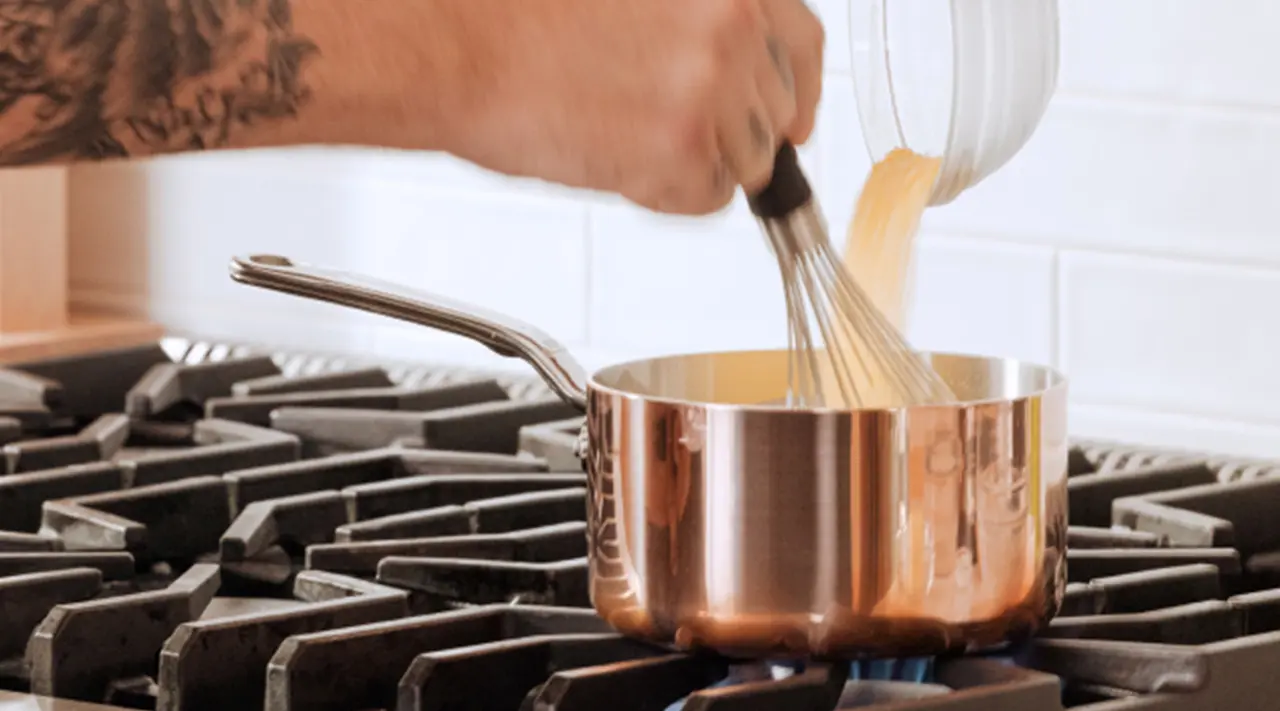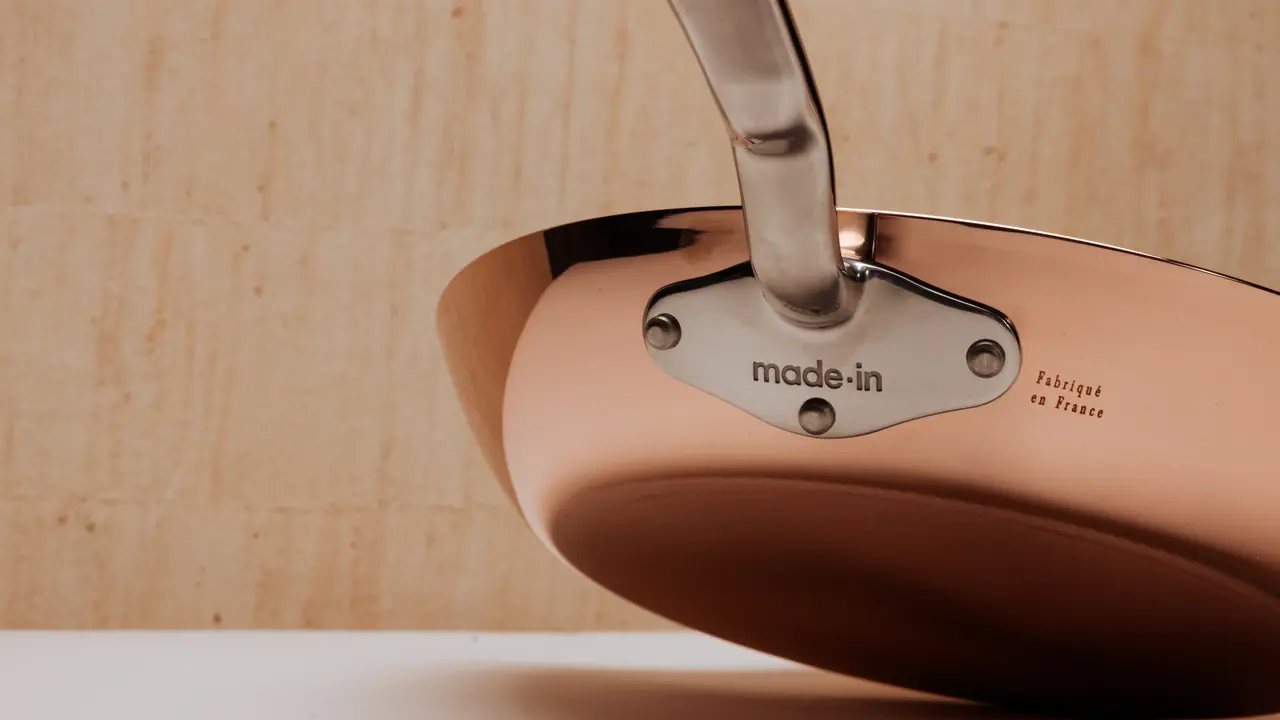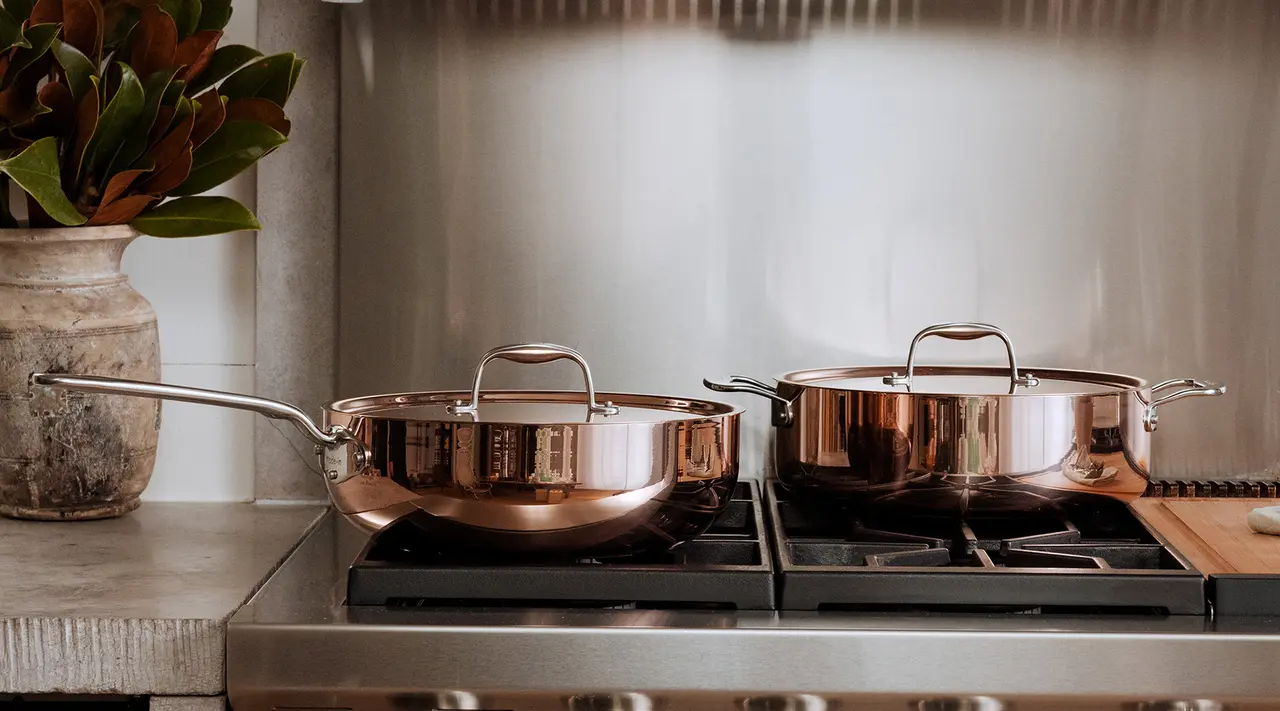Copper cookware is a bit of a rarity in modern kitchens. You may have seen idyllic pictures of copper factories in the French town of Villedieu-les-Poêles (literally, God’s City of the Pans), or peeked it gleaming on the shelf of a specialty cookware retailer—but odds are, you’ve probably never cooked with it before. And we get it: copper is pricey, and plus, how are you actually supposed to cook with it?
We’re here to demystify this beautiful cookware material, and hopefully convince you that when it comes to versatility, cooking speed, and—yes—looks, copper is well-worth the investment.
What Is Copper Cookware?

Nowadays, it's a rarity to find copper cookware that's copper through and through. Typically, a copper pot or pan sold in stores will be made with an exterior layer of copper, and a lining of tin or stainless steel. Rather than some money-saving hack on the part of the manufacturer, this lining plays a critical role in your safety, as well as your pan’s versatility.
In addition to being an incredible conductor of heat, copper is also an extremely reactive material. If it comes into contact with acidic ingredients—like citrus, vinegar, or tomatoes—the metal will start to immediately leach into the food itself. Since copper is toxic to the human body if ingested in large enough quantities, using an unlined copper pot or pan to cook acidic ingredients over a long period of time can be very harmful.
It’s also important to note the metal your pan is lined with. Tin is more common in older copper cookware, and while it’s relatively safe and even offers natural non stick properties, it has a much lower melting point than stainless steel. Tin will start to bubble and melt once it reaches 450F, so your cookware will likely need periodic retinning. Stainless linings are much more durable, can reach higher temperatures—ours can reach 800F—and doesn't need to be retinned.
Aside from stainless steel, you can also opt for pans lined with sterling silver—though, unless money is literally no object, this may not be the most practical choice.
Types of Copper Cookware

Excited to buy your first piece of copper cookware? You’re in luck: copper comes in an impressive array of shapes and styles, so you’re bound to find one that fits your cooking style
Copper Pots and Pans
In our line of copper cookware, we offer four different products: a Frying Pan, a Saucier, a Saucepan, and a Rondeau. Each of these comes with its own lid, and is made from 90% copper, 10% stainless steel. This construction makes for a long-lasting and versatile piece of cookware, just as ideal for braising or roasting as it is for making jams, caramels, or sautes.
Specialty Copper Cookware
Copper has a millenia-long history as a cookware material, so it’s not entirely surprising that you can find highly specialized copper pieces like jam pans—pans made of unlined copper and used for cooking high-sugar foods like jam—paella pans, and even a turbotier, made exclusively for poaching a whole turbot.
While we love the thought of all these whimsically-shaped pieces stacked high in our cupboards like the pantry in a French farmhouse, realistically, we recommend sticking with something practical like a copper frying pan, rondeau, or saucier. These pans showcase the gorgeous looks and great heating properties of copper, but offer just a little more versatility. For example, a rondeau is the perfect size to handle all of your roasting or braising tasks, and can easily travel from stovetop to oven.
If you’re looking to splurge a bit more, you might want to consider buying a set of copper cookware rather than a single piece. Like our new 7-Piece Copper Set, these are less expensive than buying each piece individually, and typically include staple cookware items like a frying pan, saucepan, and saute pan.
What Are the Benefits of Cooking with Copper?

Other than looking très chic, copper cooks like a dream, from searing perfect steaks to cooking up thick, glossy fruit jams. The biggest benefits copper cookware brings to your kitchen is precision, sensitivity to temperature change, and being easy to care for.
Conductivity and Heat Distribution
Conductivity, conductivity, conductivity: it’s a bit like the three Ls of real estate, but for cookware. Copper’s ability to conduct and circulate heat, as well as its responsiveness to temperature change, is one of the chief reasons to splurge on these pieces.
We love to talk up stainless steel’s conductivity and responsiveness, and copper is even better in this regard—heating up more quickly, and circulating that heat more evenly, than even stainless steel. For extremely delicate foods, like flaky fish filets or caramels, that responsiveness is key, as it allows you to quickly cut the heat to avoid overcooking or burning.
Durability and Longevity
Copper may look like a piece of precious jewelry, but it’s actually quite durable: even copper covered in verdigris—that greenish-blue layer that forms on copper as it ages—can be restored.
That being said, the natural patina that develops on copper as it ages is something to be cherished: while you can buff it away to restore your pan to its original shine, we prefer to leave it intact as a testament to its service.
Aesthetics and Elegance
This one speaks for itself. Along with being objectively beautiful, copper is relatively rare to find even in a professional kitchen these days, lending it a touch of mystique. Plus, it’s pretty neat to think about the fact that copper is the oldest metal to be worked by human hands.
How to Cook with Copper

While anyone can cook with copper, you do have to follow a few specific rules if you want to keep yourself—and your cookware—safe.
First: Remember what we said about copper being a reactive metal? Well, if you’re using an unlined copper vessel—many vintage pieces come without a tin or stainless steel lining, for example—you should be careful to avoid cooking anything acidic, like wine, tomatoes, or citrus, in your pot. The one exception here is jam, which contains enough sugar to keep the acid in the fruit from reacting with the copper.
Second: if your copper cookware is lined with tin, you’ll want to carefully monitor the temperature of your pot or pan. As we mentioned earlier, tin begins to melt at 450F, so it’s not the best for high heat cooking. No matter how careful you are with it, however, you’ll likely need to get your pan professionally retinned at some point.
One way to prevent your cookware from getting too hot is by always adding fat to your pan before heating it up, and never leaving it unattended. A stainless steel lining will make your pan much more heat resistant, with the minor downside of not being as naturally non stick as tin. That said, stainless steel linings do not need to be replaced or retinned.
Maintenance and Care

Washing your copper cookware isn’t too difficult, especially if you’re working with a stainless steel lining (note that tin and aluminum scratches more easily than stainless steel). In this case, you can use pretty much the exact same cleaning method on the inside of your pan as you would on any piece of stainless steel cookware. For the exterior of your pan, scrub gently after each use with a non-abrasive sponge, warm water, and gentle dish soap, drying thoroughly before putting it away. Avoid putting copper cookware in the dishwasher.
For a more detailed guide to copper care, as well as how to know when to polish your cookware, check out our dedicated post.
Ready to Shop?
Maybe you’re chomping at the bit to go pick up your first piece of copper cookware—or maybe your interest has just been mildly piqued. Either way, we know at least one of our French-made copper pieces will fit into your life, whether you’re a casual cook or a pro chef.























